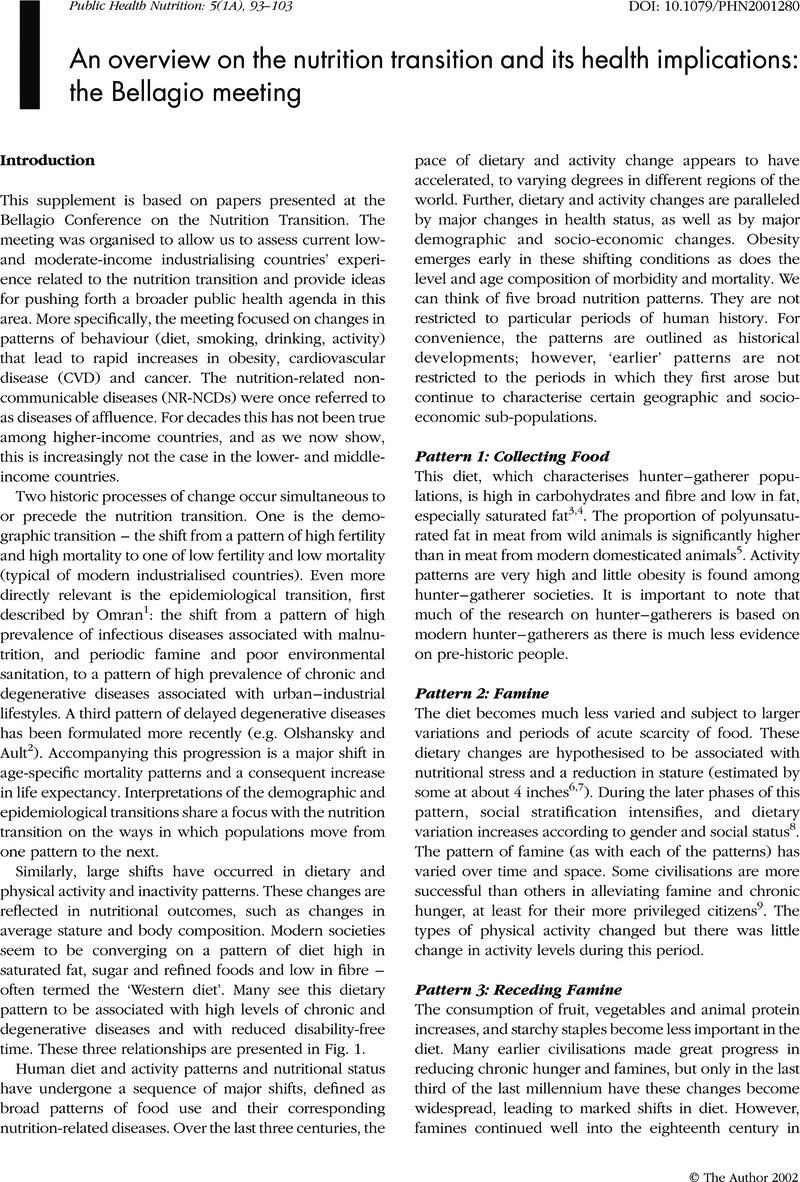Crossref Citations
This article has been cited by the following publications. This list is generated based on data provided by Crossref.
Cannon, Geoffrey
2002.
Nutrition: the new world disorder.
Asia Pacific Journal of Clinical Nutrition,
Vol. 11,
Issue. s3,
Cannon, Geoffrey
2002.
Nutrition: the new world map.
Asia Pacific Journal of Clinical Nutrition,
Vol. 11,
Issue. s3,
Wahlqvist, Mark L
2002.
Chronic disease prevention: A life‐cycle approach which takesaccount of the environmental impact and opportunities of food, nutritionand public health policies — the rationale for an eco‐nutritionaldisease nomenclature.
Asia Pacific Journal of Clinical Nutrition,
Vol. 11,
Issue. s9,
Ezzati, Majid
Lopez, Alan D
Rodgers, Anthony
Vander Hoorn, Stephen
and
Murray, Christopher JL
2002.
Selected major risk factors and global and regional burden of disease.
The Lancet,
Vol. 360,
Issue. 9343,
p.
1347.
Caballero, Benjamin
and
Popkin, Barry M.
2002.
The Nutrition Transition.
p.
1.
Popkin, Barry M.
and
Du, Shufa
2003.
Dynamics of the Nutrition Transition toward the Animal Foods Sector in China and its Implications: A Worried Perspective.
The Journal of Nutrition,
Vol. 133,
Issue. 11,
p.
3898S.
Eckhardt, Cara L.
Adair, Linda S.
Caballero, Benjamin
Avila, Josephine
Kon, Igor Y.
Wang, Jinzhong
and
Popkin, Barry M.
2003.
Estimating Body Fat from Anthropometry and Isotopic Dilution: A Four‐Country Comparison.
Obesity Research,
Vol. 11,
Issue. 12,
p.
1553.
Beaglehole, R
and
Yach, D
2003.
Globalisation and the prevention and control of non-communicable disease: the neglected chronic diseases of adults.
The Lancet,
Vol. 362,
Issue. 9387,
p.
903.
Gulliford, Martin C
Mahabir, Deepak
and
Rocke, Brian
2003.
Food insecurity, food choices, and body mass index in adults: nutrition transition in Trinidad and Tobago.
International Journal of Epidemiology,
Vol. 32,
Issue. 4,
p.
508.
Valeggia, Claudia R.
and
Ellison, Peter T.
2003.
Impact of breastfeeding on anthropometric changes in peri‐urban Toba women (Argentina).
American Journal of Human Biology,
Vol. 15,
Issue. 5,
p.
717.
Popkin, Barry M.
2003.
The Nutrition Transition in the Developing World.
Development Policy Review,
Vol. 21,
Issue. 5-6,
p.
581.
Popkin, B M
and
Gordon-Larsen, P
2004.
The nutrition transition: worldwide obesity dynamics and their determinants.
International Journal of Obesity,
Vol. 28,
Issue. S3,
p.
S2.
Roos, Gun
2004.
Encyclopedia of Medical Anthropology.
p.
178.
Colin Bell, A
Adair, Linda S
and
Popkin, Barry M
2004.
Understanding the role of mediating risk factors and proxy effects in the association between socio-economic status and untreated hypertension.
Social Science & Medicine,
Vol. 59,
Issue. 2,
p.
275.
Kain, J
Uauy, R
Albala
Vio, F
Cerda, R
and
Leyton, B
2004.
School-based obesity prevention in Chilean primary school children: methodology and evaluation of a controlled study.
International Journal of Obesity,
Vol. 28,
Issue. 4,
p.
483.
Kuhnlein, Harriet V.
2004.
Karat, Pulque, and Gac: Three Shining Stars in the Traditional Food Galaxy.
Nutrition Reviews,
Vol. 62,
Issue. 11,
p.
439.
Monteiro, Carlos A.
Conde, Wolney L.
and
Popkin, Barry M.
2004.
The Burden of Disease From Undernutrition and Overnutrition in Countries Undergoing Rapid Nutrition Transition: A View From Brazil.
American Journal of Public Health,
Vol. 94,
Issue. 3,
p.
433.
Johns, Timothy
and
Sthapit, Bhuwon R.
2004.
Biocultural Diversity in the Sustainability of Developing-Country Food Systems.
Food and Nutrition Bulletin,
Vol. 25,
Issue. 2,
p.
143.
Popkin, Barry M.
2004.
The Nutrition Transition: An Overview of World Patterns of Change.
Nutrition Reviews,
Vol. 62,
Issue. ,
p.
S140.
Hendricks, Michael K.
and
Hussey, Greg
2004.
Handbook of Nutrition and Immunity.
p.
19.



